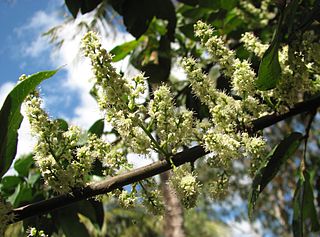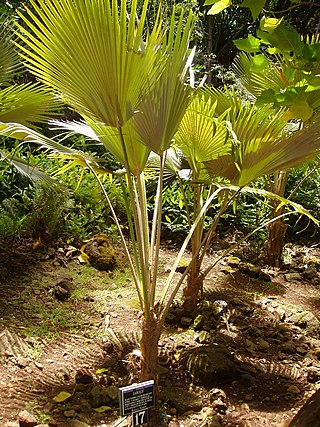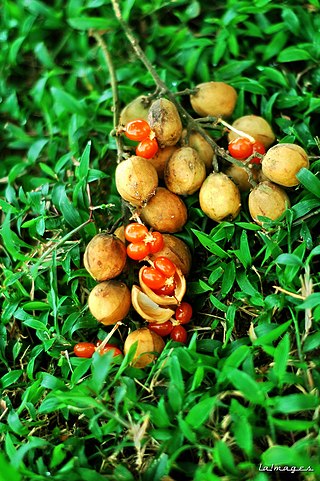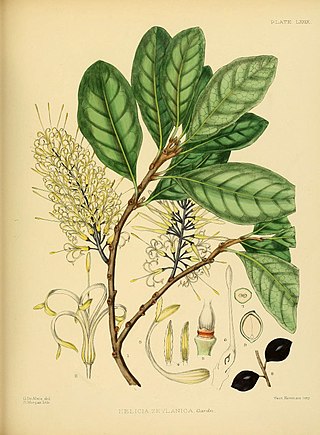
Lauraceae, or the laurels, is a plant family that includes the true laurel and its closest relatives. This family comprises about 2850 known species in about 45 genera worldwide. They are dicotyledons, and occur mainly in warm temperate and tropical regions, especially Southeast Asia and South America. Many are aromatic evergreen trees or shrubs, but some, such as Sassafras, are deciduous, or include both deciduous and evergreen trees and shrubs, especially in tropical and temperate climates. The genus Cassytha is unique in the Lauraceae in that its members are parasitic vines. Most laurels are highly poisonous.

Cupaniopsis is a genus of about 67 species of trees and shrubs of the soapberry family, Sapindaceae. They grow naturally in New Guinea, New Caledonia, Australia, Torres Strait Islands, Fiji, Samoa, Sulawesi, Micronesia. Many species have been threatened with extinction globally or nationally, with official recognition by the International Union for Conservation of Nature (IUCN) and several national and state governments.

Guioa is a genus of about 78 rainforest tree species known to science, which constitute part of the plant family Sapindaceae. They have a wide distribution, ranging from throughout Malesia, in Burma, Cambodia, Vietnam, Thailand, Malay Peninsula, Borneo, Sumatra, Philippines, Java, Flores, Timor, Sulawesi, Moluccas, New Guinea, further southwards through the east coast of Queensland and New South Wales, Australia and further eastwards to the Pacific Islands, including Tonga, New Caledonia, Fiji and Samoa.

Pritchardia limahuliensis, the Limahuli Valley pritchardia, is a palm native to Hawaii. It is a rare species, only discovered in 1977 by staff of the National Tropical Botanical Garden in the Limahuli Garden and Preserve, Kauai, Hawaii, where it is now being conserved. It is threatened by introduced rats, which eat the seeds.

Atalaya is a genus of eighteen species of trees and shrubs of the plant family Sapindaceae. As of 2013 fourteen species grow naturally in Australia and in neighbouring New Guinea only one endemic species is known to science. Three species are known growing naturally in southern Africa, including two species endemic to South Africa and one species in South Africa, Eswatini and Mozambique.

Elattostachys is a genus of about 21 species of trees known to science, constituting part of the plant family Sapindaceae.
Senegalia manubensis is a species of plant in the family Fabaceae. It is found only in Somalia, and is threatened by habitat loss. Its appearance consists of a small tree with a rounded crown, growing to a maximum of 5 metres tall.

Eriolaena is a genus of flowering plants. Traditionally included in the family Sterculiaceae, it is included now in the recently expanded Malvaceae. The genus is distributed in Asia and eastern Africa, from southern China through Indochina to India, Bangladesh, Nepal, Sri Lanka, Madagascar, and coastal Mozambique.

Normanbya is a monotypic genus of palms containing the single species Normanbya normanbyi, which is known by the common name black palm It is endemic to Queensland, Australia and is threatened by habitat destruction.

Anacolosa densiflora is a species of plant in the Olacaceae family. Currently, it is an endangered species that is endemic to India.

Baccaurea polyneura is a species of plant in the family Phyllanthaceae. It is native to Peninsular Malaysia, and Sumatra island of Indonesia. The fruit, called jentik, is edible, if sour, and is locally harvested and sold.
Breviea is a genus of plant in the family Sapotaceae described in 1935.
Cassipourea eketensis is a species of plant in the Rhizophoraceae family. It is endemic to Nigeria and grows in tropical rainforest. It is threatened by habitat loss.
Zanthoxylum mezoneurispinosum, synonym Fagara mezoneurispinosa, is a species of plant in the family Rutaceae. It is endemic to lowland tropical rainforests of Ivory Coast.
Ficus pakkensis is a species of plant in the family Moraceae, native to tropical northern South America.

Helicia is a genus of 110 species of trees and shrubs, constituting part of the plant family Proteaceae. They grow naturally in rainforests throughout tropical South and Southeast Asia, including India, Sri Lanka, Indochina, Peninsular Malaysia to New Guinea and as far south as New South Wales.

Mangifera foetida is a species of plant in the family Anacardiaceae. It is found in wet-land rainforest regions of Indonesia, Malaysia, Myanmar, Singapore, Thailand, and Vietnam.
Prunus javanica is a species of plant in the family Rosaceae. It is found in India, Indonesia, Malaysia, and Myanmar.

Siphoneugena densiflora is a species of plant in the family Myrtaceae. It is endemic to Brazil. Typically found as a shrub up to 3 metres tall, and more rarely as a tree up to between 12 and 13 metres tall, this plant produces edible purplish-black fruit that are less than 10mm in diameter.
Vepris trifoliolata is a species of plant in the family Rutaceae. It is endemic to Cameroon. Its natural habitats are subtropical or tropical moist lowland forests and subtropical or tropical moist montane forests. It is threatened by habitat loss.













